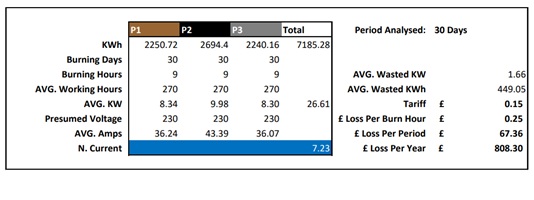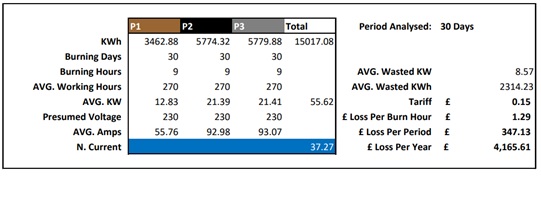Energy management is becoming an increasingly important component of business strategy for today’s FMCG companies, aimed largely at reducing energy costs, improving sustainability, and achieving ESG goals. According to the 2020 Deloitte Resources Study, half of industrial companies report incorporating energy management at the corporate strategy level, says Matthew Margetts, director of sales and marketing at Smarter Technologies.
But there’s an element of energy management that’s often overlooked when large FMCG companies are identifying ways to reduce energy costs and optimise consumption energy load balancing.
What is load balancing and why is it important?
Large commercial and industrial properties (where half hourly electricity meters have been installed) have what is called three-phase supply the power comes into the property and is split into three further phases. This is unlike residential or small commercial outlets which have single-phase electricity.
When electrical equipment is installed at a unit using a three-phase system, it draws power across the three phases to operate. In general, three-phase load balancing is the ideal situation for any electrical system as it determines the quality of delivered electrical power. In a balanced system, the total active/reactive/apparent powers are simply the sum of their respective phase powers. Put simply, power delivered to the premises is ideal and 100% efficient with no losses. However, as businesses evolve and add to their loads, the electricity provision can become unbalanced, leading to inefficiencies.
An unbalanced system has a negative effect on power quality of electrical power at the distribution level. The voltages are quite well balanced from the source (the electricity board), but the voltage levels in the building can become unbalanced due to:
- Unequal system impedances
- Unequal distribution of single-phase loads
- Asymmetrical three-phase equipment and devices
- Unbalanced faults
- Damaged wiring, and more
In short, as more is added to a system over time, the more likely that the installer is not aware of the operating power load and is simply fitting the equipment where there is space available in the fuse board.
Phase balancing is very important to reduce distribution feeder losses and improve system stability and security.
Here are some of the advantages of load balancing:
- Reduces neutral back flow, reducing power wastage
- Stable voltage levels on individual phases
- Reduces equipment damage
- Longer cable life
- Prevents fire and other accidents
Unbalanced load effects:
- Causes difference in voltage across the individual phases
- Can damage equipment due to voltage drop
- Cable damage due to excessive current on a phase
Real-time data leads to real savings
IoT consultancy Smarter Technologies was approached by a large UK bakery to help them determine how much energy they were wasting through an imbalanced load. With multiple large ovens consuming a lot of energy, they knew that the savings could be significant in terms of both energy consumption costs and the maintenance and lifespan of their equipment.
Understanding load balancing opportunities begins by having energy consumption data and the ability to analyse it. Smarter Technologies used its SmarterView platform to review of the electricity being used on site. The real-time data from the bakery’s smart meters is collected, displayed and analysed on the cloud-based SmarterView platform, which Smarter Technologies used to determine:
- Whether there was sufficient power to support EV charging
- Whether there was sufficient power to support an electric oven (64KV power load)
In evaluating the data, Smarter Technologies sought to identify patterns that demonstrated a consistent load difference between the phases in excess of 25%. To determine what power might be available, the team looked at how the operations of the business affect the amount of power required. It was immediately apparent that the electricity load is imbalanced. Besides being a significant financial cost, the unbalanced system also affected the availability of power to support wider initiatives.
Calculating the cost of an unbalanced system
The cost of the wasted electricity at the bakery has been estimated on a kWh unit charge of £0.15 (fifteen pence), although the actual cost/loss will proportionally alter based on the actual price the bakery is paying.
The total cost of the supply imbalance over the two units is £4,973.91 per year.
Data from Bakery Unit 1

Data from Bakery Unit 2

Conclusion
As a result of the load balancing audit, the bakery was able to take remedial steps to balance its energy load and save close to £5000 a year. Although there are some initial costs to get the load balanced, these are still likely to be far less than the annual wastage.
Recovering the wastage reduces long-terms costs and improves the business’ carbon footprint, as electricity not being used by the ovens can be diverted to another use, such as electric vehicle (EV) charging. Rebalancing the load will allow Smarter Technologies to identify the extent to which EV chargers can be fitted, as the number of units and the available charge load and timings can only be confirmed once the true available capacity is understood.
Information on energy load balancing is rarely surfaced, but understanding the utilisation of power in a business is as important as knowing the cost of energy especially if it is being wasted and limiting the scope of operations. As the old adage goes, you can’t manage what you don’t measure, so having the accurate, real-time energy consumption data at the tip of one’s fingertips is a crucial piece of the puzzle when it comes to optimising energy management.
The author is Matthew Margetts is director of sales and marketing at Smarter Technologies.
About the author
Matthew Margetts is director of sales and marketing at Smarter Technologies. His background includes working for blue-chip companies such as AppNexus, AOL/ Verizon, and Microsoft in the UK, Far East and Australia.
Comment on this article below or via Twitter: @IoTNow_OR @jcIoTnow.






